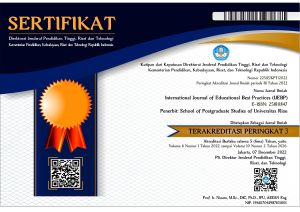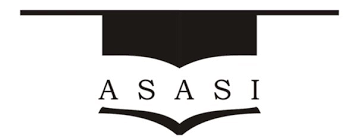Collaborative Written Feedback Experience: A Case Study of Indonesian EFL Students in an Essay Writing Class
DOI:
https://doi.org/10.31258/ijebp.1.2.24-37Keywords:
peer feedback, collaborative writing instruction, collaborative written feedback, EFL writingAbstract
Implementing collaborative written feedback instruction is a way to develop students‘ awarenes of writing as a process, the benefits of peer review and feedback, and the important roles of peer interaction for learning. The current research aimed at understanding students‘ experiences of providing and responding to written feedback in group. It specifically sought to answer these questions: 1.) What are students‘ perceptions toward collaborative written feedback experience? 2) What are students‘ collaborative written feedback practices? and 3). What factors affect students‘ collaborative written feedback experience? Conducted as a qualitative case study, the research reported the collaborative written feedback experiences of a group of three undergradutae EFL students in Essay Writing course. Data were drawn from observations, focus group interview, student reflective essay, and collection of related documents and artifacts. The findings show that students have positive perceptions toward collaborative written feedback instruction citing that it helps them improve their writing and develop their interpersonal skills. The study also reveals that changing roles in the group and the use of media paltform to communicate are among the strategies employed in collaborative written feedback practices. Factors such as peer‘s characteristics, level of confidence and task seemed to have affected these practices. Suggestions on the ways in which collaborative written feedback instruction can be implemented effectively are also provided.
References
Bogdan, R. C., & Biklen, S. K. (2007). Qualitative research for education: An introduction to theories and methods (5th Ed.). New York: Pearson.
Burkert, A. & Wally, J. (2013). Peer reviewing in in a collaborative teaching and learning environment. In M. Reitbauer, N. Campbell, S. Mercer, & J. Schumm
Fauster (Eds.), Feedback matters: Current feedback practices in the EFL classroom, (pp. 69-86). New York: Peter Lang Edition.
Celce-Murcia, M. (2001). Teaching English as a second or foreign language (3rd ed.). Boston: Heinle & Heinle.
Chatranonth, Phnita. (2008). The impact of teacher feedback on students‟ grammatical writing accuracy: A case study in Thailand. (Doctoral dissertation). Retrieved from Manchester: The University of Manchester.
Creswell, J. W., & Creswell, J. W. (2013). Qualitative inquiry and research design: Choosing among five approaches. Los Angeles: SAGE Publications.
Fernández Dobao, A. (2012). Collaborative writing tasks in the L2 classroom: Comparing group, pair, and individual work. Journal of Second Language Writing, 21(1), 40-58.
Fernández Dobao, A., & Blum, A. (2013). Collaborative writing in pairs and small groups: Learners‘ attitudes and perceptions. System, 41(2), 365-378.
Ferris, D. R., & Hedgcock, J. S. (2005). Teaching ESL Composition: Purpose, Process, & Practice (2nd ed.). New Jersey: Lawrence Erlbaum.
Harmer, J. (2007). How to teach English. Harlow, England: Pearson Education Limited.
Hu, G. W., & Lam, S. T. E. (2010). Issues of cultural appropriateness and pedagogical efficacy: Exploring peer review in a second language writing class. Instructional Science, 38, 371-394.
Hyland, K. & Hyland, F. (2006). Feedback on second language students‘ writing. Language Teaching, 0(2), 83-101.
Hyland, K. (2009). Teaching and researching writing (2nd. Ed.). London: Pearson Education Limited.
Hirose, Keiko. (2008). Peer feedback in L2 writing instruction. In K. Bradford Watts, T. & M. Swanson (Eds.), JALT 2007 Conference Proceedings. Tokyo: JALT.
Lai, E. R. (2011). Collaboration: A literature review. Retrieved from http://www.pearsonassessments.com/hai/images/tmrs/Collaboration-Review.pdf
Liu, J., & Hansen, J. (2002). Peer response in second language writing classroom. Ann Arbor, MI: University of Michigan Press.
Liu, M., & Chai, Y. (2009). Attitudes toward peer review and reaction to peer feedback in Chinese EFL writing classroom. TESL Reporter, 42(1), 33-51.
Lantolf, J. P., & Thorne, S. (2006) Sociocultural theory and the genesis of second language development. Oxford: Oxford University Press.
Long, M. (1996). The role of the linguistic environment in second language acquisition. In R. William & T. Bhatia (Eds.), Handbook of Second Language Acquisition (pp. 413-468). San Diego: Academic Press.
Lundstrom, K. & Baker, W. (2009). To give is better than to receive: The benefits of peer review to the reviewer‘s own writing. Journal of Second Language Writing. 18(1), 30-43.
Marshall, C., & Rossman, G. (2011). Designing qualitative research (5th ed.). London: Sage. Merriam, S. B. (2009). Qualitative research: A guide to design and implementation. Revised and expanded from qualitative research and case study applications in education. San Fransisco: Jossey-Bass A Wiley Imprint.
McAllister, C. H. (2005). Collaborative writing groups in the college classroom. In T. Kostouli (Ed.), Writing in context(s): Textual practices and learning processes in sociocultural settings (pp. 207-228). New York: Springer.
Mutwarasibo, F. (2013). Promoting university students‘ collaborative learning through instructor-guided writing groups. International Journal of Higher Education, 2(3), 1-11.
Pathinathan, S., & Yong, M. F. (2012). Intragroup conflicts during collaborative writing in an ESL/EFL preparatory programme. International Journal of Applied Linguistics & English Literature,
1(7). Retrieved from http://www.ijalel.org/pdf/173.pdf
Rezeki, Y. S. (2016). Indonesian English-as-a-foreign language learners‟ experiences in collaborative writing. (Doctoral Dissertation, University of Rochester, Rochester). Retrieved from http://hdl.handle.net/1802/30856
Rezeki, Y. S. (2016). Language learning affordances in collaborative writing: A qualitative case study of Indonesian EFL undergraduate students. Paper presented to the 63rd TEFLIN 2016 Conference, Surabaya.
Richards, J. C., & Renandya, W. A. (2002). Methodology in language teaching: An anthology of current practice. Cambridge, U.K./New York: Cambridge University Press.
Storch, N. (2005). Collaborative writing: Product, process and students‘ reflection. Journal of Second Language Writing, 14, 153-173.
Storch, N. (2013). Collaborative writing in L2 classrooms: New perspective on language and education. Tonawanda, NY: Multilingual Matters.
Swain, M. (2000). The output hypothesis and beyond: Mediating acquisition through collaborative dialogue. In J. P. Lantolf (Ed.), Sociocultural theory and second language learning (pp. 97-114). Oxford: Oxford University Press.
Tang, R. (Ed.). (2012). Academic writing in a second or foreign language: Issues and challenges facing ESL/EFL academic writers in higher education contexts. London: Continuum International Pub.
Vygotsky, L., S. (1978). Mind in society: The development of higher psychological processes. Cambridge, MA: Harvard University Press.
Yin, R. (2014). The case study research: Design and methods (5th Ed.). Thousand Oaks: CA. Sage Publications, Inc.
Yu, S., & Hu, G. (2016) Can higher-proficiency L2 learners benefit from working with lower-proficiency partners in peer feedback?, Teaching in Higher Education, DOI: 10.1080/13562517.2016.1221806
Yu, S. & Hu, G. (2017). Understanding university students‘ peer feedback practices in EFL writing: Insights from a case study. Assessing Writing, 33, 25-35.
Yu, S., & Lee, I. (2014). Understanding EFL students‘ participation in group peer feedback of L2 writing: A case study from an activity theory perspective. Language Teaching, DOI: 10.1177/1362168814541714





